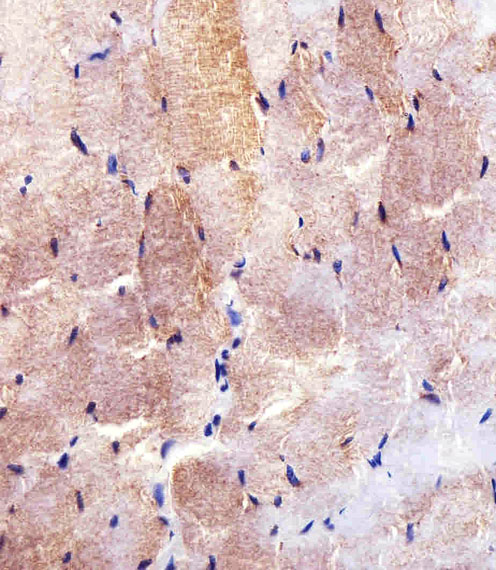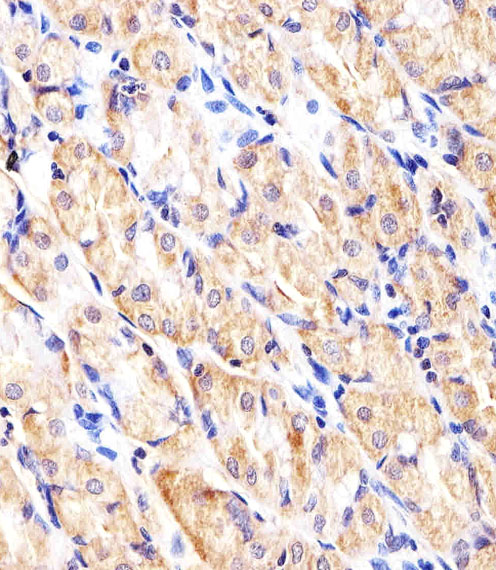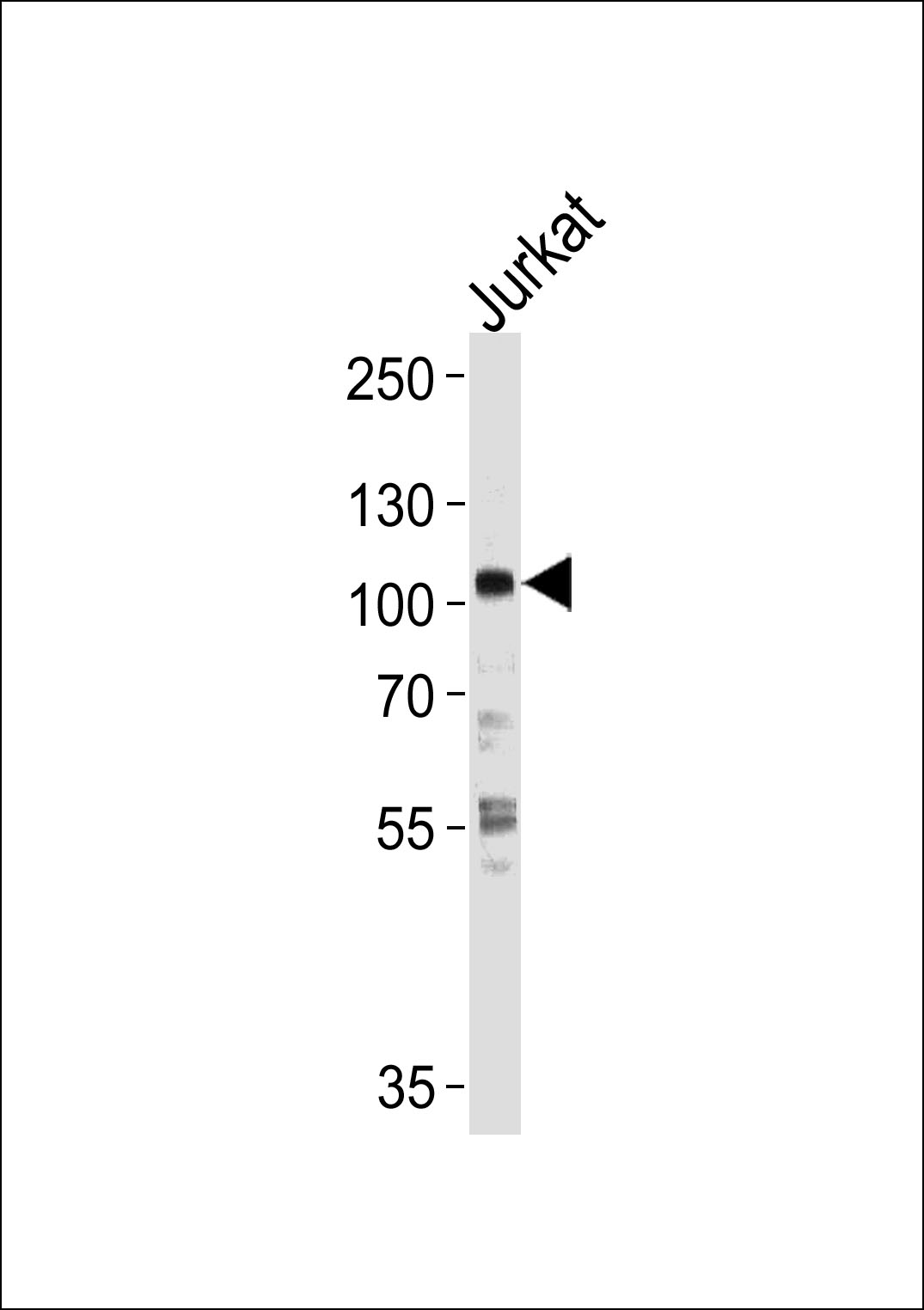HK2 (Hexokinase II) Antibody (Center)
Purified Rabbit Polyclonal Antibody (Pab)
- 产品详情
- 实验流程
- 背景知识
Application
| WB, IHC-P, E |
|---|---|
| Primary Accession | P52789 |
| Other Accession | NP_000180 |
| Reactivity | Human, Rat, Mouse |
| Host | Rabbit |
| Clonality | Polyclonal |
| Isotype | Rabbit IgG |
| Calculated MW | 102380 Da |
| Antigen Region | 453-483 aa |
| Gene ID | 3099 |
|---|---|
| Other Names | Hexokinase-2, Hexokinase type II, HK II, Muscle form hexokinase, HK2 |
| Target/Specificity | This HK2 (Hexokinase II) antibody is generated from rabbits immunized with a KLH conjugated synthetic peptide between 453-483 amino acids from the Central region of human HK2 (Hexokinase II). |
| Dilution | WB~~1:1000 IHC-P~~1:100 E~~Use at an assay dependent concentration. |
| Format | Purified polyclonal antibody supplied in PBS with 0.09% (W/V) sodium azide. This antibody is prepared by Saturated Ammonium Sulfate (SAS) precipitation followed by dialysis against PBS. |
| Storage | Maintain refrigerated at 2-8°C for up to 2 weeks. For long term storage store at -20°C in small aliquots to prevent freeze-thaw cycles. |
| Precautions | HK2 (Hexokinase II) Antibody (Center) is for research use only and not for use in diagnostic or therapeutic procedures. |
| Name | HK2 (HGNC:4923) |
|---|---|
| Function | Catalyzes the phosphorylation of hexose, such as D-glucose and D-fructose, to hexose 6-phosphate (D-glucose 6-phosphate and D- fructose 6-phosphate, respectively) (PubMed:23185017, PubMed:26985301, PubMed:29298880). Mediates the initial step of glycolysis by catalyzing phosphorylation of D-glucose to D-glucose 6-phosphate (PubMed:29298880). Plays a key role in maintaining the integrity of the outer mitochondrial membrane by preventing the release of apoptogenic molecules from the intermembrane space and subsequent apoptosis (PubMed:18350175). |
| Cellular Location | Mitochondrion outer membrane; Peripheral membrane protein. Cytoplasm, cytosol Note=The mitochondrial-binding peptide (MBP) region promotes association with the mitochondrial outer membrane (PubMed:29298880) The interaction with the mitochondrial outer membrane via the mitochondrial-binding peptide (MBP) region promotes higher stability of the protein (PubMed:29298880). Release from the mitochondrial outer membrane into the cytosol induces permeability transition pore (PTP) opening and apoptosis (PubMed:18350175). |
| Tissue Location | Predominant hexokinase isozyme expressed in insulin-responsive tissues such as skeletal muscle |
For Research Use Only. Not For Use In Diagnostic Procedures.
Provided below are standard protocols that you may find useful for product applications.
BACKGROUND
In vertebrates there are four major glucose-phosphorylating isoenzymes, designated hexokinase I, II, III, and IV. Hexokinase is an allosteric enzyme inhibited by its product GLC-6-P. Hexokinase activity is involved in the first step in several metabolic pathways. HK3 is bound to the outer mitochondrial membrane. Its hydrophobic N-terminal sequence may be involved in membrane bindng. It is the predominant hexokinase isozyme expressed in insuline-responsive tissues such as skeletal muscle. The N- and C-terminal halves of this hexokinase show extensive sequence similarity to each other. The catalytic activity is associated with the C-terminus while regulatory function is associated wiht the N-terminus. Although found in NIDDM patients, genetic variations of HK2 do not contribute to the disease.
REFERENCES
Lehto, M., et al., Diabetologia 38(12):1466-1474 (1995).
Vidal-Puig, A., et al., Diabetes 44(3):340-346 (1995).
Laakso, M., et al., Diabetes 44(3):330-334 (1995).
Echwald, S.M., et al., Diabetes 44(3):347-353 (1995).
Shinohara, Y., et al., Cancer Lett. 82(1):27-32 (1994).
终于等到您。ABCEPTA(百远生物)抗体产品。
点击下方“我要评价 ”按钮提交您的反馈信息,您的反馈和评价是我们最宝贵的财富之一,
我们将在1-3个工作日内处理您的反馈信息。
如有疑问,联系:0512-88856768 tech-china@abcepta.com.























 癌症的基本特征包括细胞增殖、血管生成、迁移、凋亡逃避机制和细胞永生等。找到癌症发生过程中这些通路的关键标记物和对应的抗体用于检测至关重要。
癌症的基本特征包括细胞增殖、血管生成、迁移、凋亡逃避机制和细胞永生等。找到癌症发生过程中这些通路的关键标记物和对应的抗体用于检测至关重要。 为您推荐一个泛素化位点预测神器——泛素化分析工具,可以为您的蛋白的泛素化位点作出预测和评分。
为您推荐一个泛素化位点预测神器——泛素化分析工具,可以为您的蛋白的泛素化位点作出预测和评分。 细胞自噬受体图形绘图工具为你的蛋白的细胞受体结合位点作出预测和评分,识别结合到自噬通路中的蛋白是非常重要的,便于让我们理解自噬在正常生理、病理过程中的作用,如发育、细胞分化、神经退化性疾病、压力条件下、感染和癌症。
细胞自噬受体图形绘图工具为你的蛋白的细胞受体结合位点作出预测和评分,识别结合到自噬通路中的蛋白是非常重要的,便于让我们理解自噬在正常生理、病理过程中的作用,如发育、细胞分化、神经退化性疾病、压力条件下、感染和癌症。








